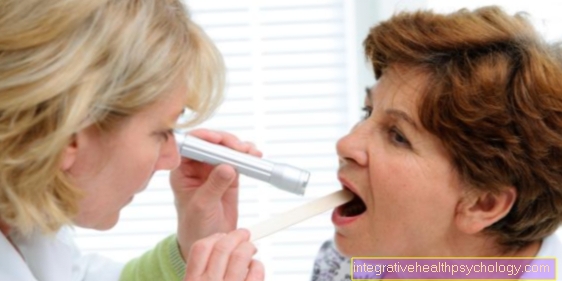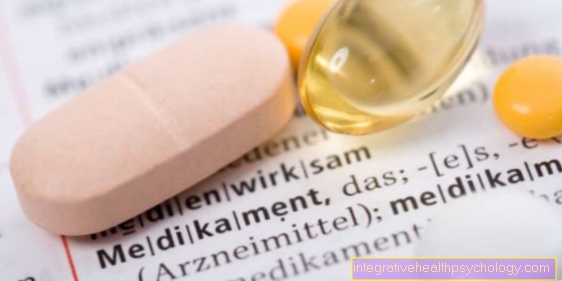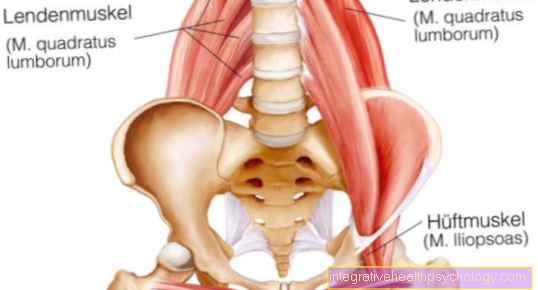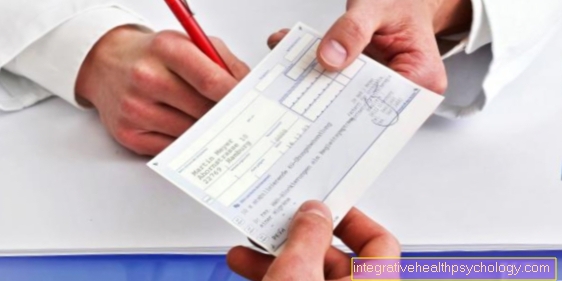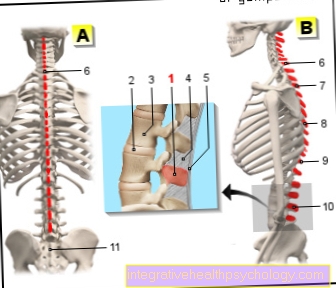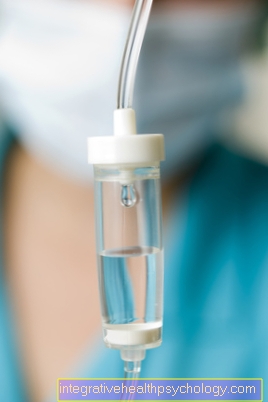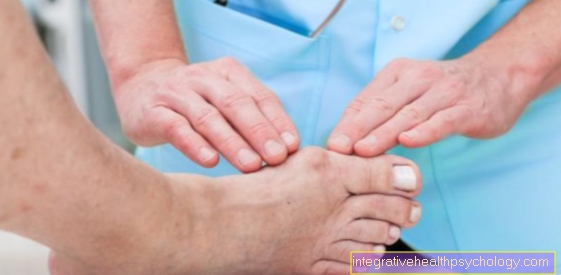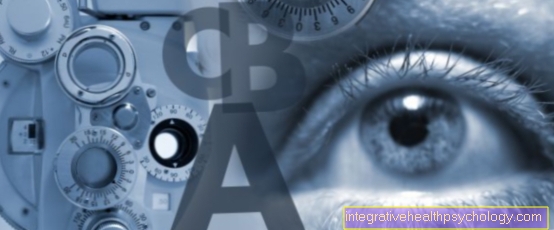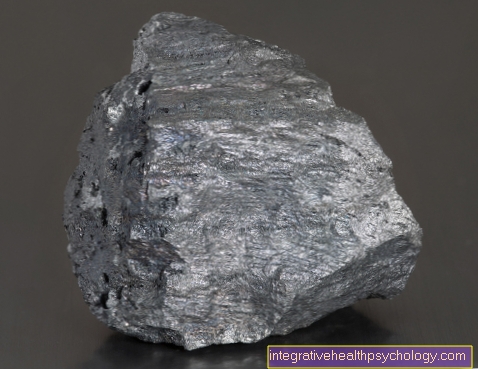resuscitation
Synonyms in the broader sense
Resuscitation, Cardiopulmonary Resuscitation, Cardiopulmonary Resuscitation
English: resuscitation
definition
Under resuscitation one understands measures to end a breathing and circulatory arrest.
There are several types of Cardiac arrest and measures are differentiated. So there are the basic measures that everyone in the course "first aid“Learned for the driver's license up to professional resuscitation in the hospital by the emergency doctor-led resuscitation team. With this method, depending on the type of cardiac arrest, aids such as medication or a defibrillator are used.
Resuscitation measures
Basic measures

The basic measures of resuscitation are exactly what you learn in the first aid course for the driver's license. The measure is explained here using an example:
Our patient is found lying on his back, apparently unconscious.
He is spoken to first, if he does not respond to loud speech, his shoulder is shaken lightly. If there is no response to this, the breathing must first be checked. To do this, the head is overstretched, i.e. brought into the position as if the patient was trying to look back without turning around.
The examiner goes with his ear directly over his mouth and looks at the chest, on which he can still put his hand. He can check his breathing in three ways at the same time: he sees whether the chest is rising and falling, hears the breathing noise and feels it on the ear. If there is no breathing, the emergency services will be alerted now at the latest.
The examiner then immediately starts with chest compressions. This is done without feeling the pulse beforehand. Studies have shown that laypeople have problems finding their pulse anyway, and in the excitement of leading a resuscitation anyway not. In addition, the rule of thumb applies: if you are not breathing, you will not have a pulse shortly after you stop breathing.
With chest compressions (for details see chest compressions), press 30 times, then ventilate twice. And always alternating. This change from pressing thirty times, ventilating twice is carried out until the emergency service arrives or you can no longer.
The speed can be based on the melody of the Beatles song "Yellow Submarine".
Also read that Articles on the topic: First aid
Advanced measures

Now in our example it is the case that we are at the airport. There are now so-called "A.utomatic E.xternal D.efibrillators "(AED). This is now fetched by the ground staff and connected by the first aid providers. The instructions are very easy and explained with pictures on the devices. The electrodes are attached according to the pictures and the defibrillator is switched on.
From now on, he “directs” them resuscitation. The device specifies the times for how long the key is pressed and automatically analyzes this in short pauses EKG (electrocardiogram). Then the device decides whether an electric shock is necessary or not.
Both hyperdynames (please refer: Cardiac arrest) Shapes will be shocked. This can be explained using the example described above. The conductor draws attention to himself by knocking loudly with the baton (shock). The conductor (sinus node in the heart) sets the pace again and, if it works, it continues harmoniously.
If the shock is not enough, the rhythm of pressing thirty times and ventilating twice is resumed for another 2 minutes. Only then does the device analyze again and, if necessary, also shock.
Professional measures

Finally, after our first aiders have carried out the basic measures and then the extended measures in an exemplary manner, the professionals are now taking over the resuscitation. These move with you R.rescuetransportwagen (Ambulance) and one Nemergency doctor E.use F.vehicle (NEF) on.
One immediately takes over Chest compressions. The others connect their own defibrillator. They also secure breathing by connecting the resuscitator to pure oxygen and using it to ventilate through a mask until they are intubate.
Access to the blood vessels for drugs must also be created. This is usually done through a vein in the arm. (For details on access types see below)
Even the professionals press for two minutes in 30 to 2 alternations and then analyze the rhythm themselves. After the third shock, the first time adrenaline administered (1mg). This should stimulate our heart muscle cells to beat again, especially the sinus accounts, so that the excitation starts again in an orderly manner.
Since the further therapy after the EKG it is explained under the individual paragraphs.
Shows the EKG Ventricular fibrillation or one pulseless ventricular tachcardia is shocked with the defibrillator. The first shock with 200 joules, the following with 360 joules. The rhythm is analyzed again every 2 minutes and shocked accordingly. Every 3-5 minutes will come back adrenaline administered.
Does the EKG show pulseless electrical activity or Asystole will not be shocked. In the Asystole there is no electrical activity in the heart at all. Pulseless electrical activity describes a state in which there is electrical activity but no mechanical activity due to decoupling. This means that there is activity on the EKG, but there is Heart no muscle contraction. In both cases only adrenaline is administered every 3-5 minutes and the rhythm is analyzed again every 2 minutes.
In hypothermic patients with a body temperature of below 270C Must not be shocked at all, no matter which EKG image is displayed. The blood would crystallize when it was hypothermic and would not carry any oxygen at all.
The Resuscitation in the hospital works almost the same way. However, the first aiders here are the trained hospital staff who alert the resuscitation team from the intensive care unit. Like the ambulance service, these come with the Defibrillator to. At each station there are so-called emergency trolleys on which everything needed for resuscitation is available. (Venous accesses, resuscitators, tubes with the appropriate material and medication with the associated syringes)
Chest compressions

The Chest compressions takes over at the resuscitation the pumping capacity of the heart until it beats properly again. The pressure point is in the middle of the Rib cage, a little to the left (1cm) of Sternum. The chest is about 5 cm Depressed deeply and also properly relieved. This is important so that the heart can fill up with blood again. At rest, the heart beats about 80 times per minute.
So that this is also approximately fulfilled in resuscitation, you try to press about 100 times a minute, because after pressing 30 times you interrupt to ventilate twice. This form has proven to be very effective, whereby the prognosis for the patient applies: The earlier resuscitation is started, the better.
Access types
Around Medication to administer, one needs access to the Vascular system. The easiest way to start with is this peripheral venous access into an arm vein. This is the approach you know from the hospital. Liquids and medication can be safely administered through this. However, pricking this access is more difficult than in the clinic, since the patient, when resuscitated, does not Blood pressure has more and therefore hardly any veins can be found.
If a peripheral access does not work at all, the method remains in one central vein to sting.
That is then a Central venous access. In this case, the access is placed in the jugular vein. This is riskier again, as you can injure significantly more on your neck than on your arm and there is a greater risk of infection there.
However, this plays a minor role in resuscitation. For this you can also give more fluid over a shorter period of time via a central access. However, this method also takes significantly more time than the peripheral venous access and requires more practice, rest and material.
Another method is to access one directly bone, a so-called intraosseous access. At first that sounds a lot worse than it actually is. Since bones are very well supplied with blood, they are injected Medication distributed very quickly through the veins. There are ready-made sets to provide such access. In these there is a sterile needle that is inserted into the bone using a device "shot" become. That also sounds more brutal than it is. You can imagine how the device is pierced with the ears. In children (here the veins are usually still much too small for peripheral access and central access would not always be appropriate) this method is very widespread, whereby it is carried out under local anesthesia.
That would also be done with awake adults. Since the method is quite simple and quick, it is becoming increasingly popular for resuscitation.
Medication
During the resuscitation two drugs are given after the third heart rhythm analysis. once adrenaline (1mg) and then Amioradon (300mg), both are administered in quick succession. Adrenaline is also a body's own messenger substance that the Heart rate and increases blood pressure by constricting blood vessels.
It has many more functions, but they are not important here. This combination is also used in resuscitation. Due to the constriction of the blood vessels, the blood is more likely to be brought to the center of the body. This usually also happens when it's cold or Shock. In this way, the body secures the blood supply to the vital organs and the brain.
Amiodarone is a so-called Antiarhythmic. That said, it's a drug against Cardiac arrhythmias. This now also helps the irregularly excited heart to excite again in the normal way.
Measures in the hospital
In the hospital, the patient is transferred directly to the intensive care unit, even if he is in need of resuscitation in the hospital. There you start directly with one Hypothermia therapy (Hypothermia). The patient is cooled down with 40 C cold infusion solutions to approx. 32-340 C for 12-24 hours. This approach reduces brain damage. At the same time, care is taken to ensure that all other values such as blood pressure, pulse or blood sugar are only in the normal range in order to give the body optimal conditions to recover. At the same time one tries to find the cause of the Cardiac arrest diagnose and treat. So the patient can with Heart attack for example one Cardiac catheter to get.
forecast
The prognosis after a resuscitation depends very much on the cause of the cardiac arrest, also on the pre-existing underlying diseases and how quickly resuscitation was started.
Therefore, there is no generally valid prognosis for resuscitation patients. Our Neurons of all body cells are the most sensitive to oxygen deprivation. After only 3-5 minutes of cardiac arrest, permanent brain damage can occur. According to the guidelines, the ambulance service arrives in Germany after approx. 8 minutes. This is why it is so important that first aiders also dare to reanimate themselves.
That can triple your chances of survival. Every minute that passes without chest compressions, the chance of survival decreases by 10%.
more information on this topic
- Ventilation
- Forms of cardiac arrest
- Resuscitation in the infant
further interesting information from this area:
- Heart attack
- Heart attack in women
- Heart attack symptoms
- Heart attack stent
- Cardiovascular arrest
- Cardiac arrhythmia
- Racing heart
- coronary heart disease
- Amiodarone
- Signs of heart attack
You can find an overview of all published topics in this area at: Diseases of the heart



